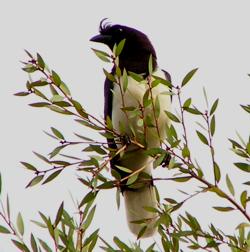
The saw-billed hermit is a hummingbird in the family Trochilidae. It is endemic to Brazil.

The rufous-breasted hermit or hairy hermit is a hummingbird that breeds from Panama south to Bolivia, and on Trinidad, Tobago and Grenada. It is a widespread and generally common species, though local populations may change in numbers and disappear altogether in marginal habitat.

Zona da Mata is a mesoregion of the state of Minas Gerais, Brazil, situated in the southeastern part of the state, along the border of the states of Minas Gerais, Rio de Janeiro and Espírito Santo. The region has a lot of hills, and the heights varies from 100 to 1,900 meters. The most important river is the Paraíba do Sul.

The Cerrado is a vast ecoregion of tropical savanna in eastern Brazil, being present in the states of Goiás, Mato Grosso do Sul, Mato Grosso, Tocantins, Maranhão, Piauí, Bahia, Minas Gerais, São Paulo, Paraná and the Federal District. The core areas of the Cerrado biome are the Brazilian highlands – the Planalto. The main habitat types of the Cerrado consist of forest savanna, wooded savanna, park savanna and gramineous-woody savanna. The Cerrado also includes savanna wetlands and gallery forests.

The white-headed marsh tyrant, also known as simply the marsh tyrant, is a small passerine bird in the tyrant flycatcher family, the only species of the genus Arundinicola. It breeds in tropical South America from Colombia, Venezuela and Trinidad south to Bolivia, Argentina and Paraguay.

The Federal University of Viçosa is a Federal University with the main campus located in the city of Viçosa, state of Minas Gerais, Brazil. The university began as the Higher College of Agriculture and Veterinary Science created in 1922 but with classes only beginning in 1927. In 1948 it was transformed into the Rural University of Minas Gerais. It was federalized in 1969 with its present name.

Caparaó National Park is a national park created in 1961 to protect the Caparaó Mountains, located on the border between Minas Gerais and Espírito Santo states in Brazil. Pico da Bandeira, one of the highest mountains in Brazil, is located there.
Justicia triloba is a species of flowering plant in the family Acanthaceae. It a shrub native to the Caatinga vegetation and Cerrado vegetation of Brazil, ranging from Tocantins to Piauí and Minas Gerais states.
Lepidagathis montana is a species of plant in the acanthus family, Acanthaceae. It is native to central Brazil, including the Espinhaço Range of Minas Gerais state northward to the Chapada Diamantina of Bahia state, and in the Federal District, Goias, and southern Maranhão. It grows in gallery forest and cerrado (savanna) in the southern part of its range. In the northern part of its range in Bahia state it grows in campo rupestre and scrubland.

Mendoncia is a genus of climbing plants in the family Acanthaceae.

Aspidosperma cylindrocarpon is a timber tree native to Brazil, Paraguay, Bolivia, and Peru. It is common in Atlantic Forest, Cerrado and Pantanal vegetation of Brazil. This plant is cited in Flora Brasiliensis by Carl Friedrich Philipp von Martius. In addition, it is useful for beekeeping.

The curl-crested jay is a species of jay native to South America.

The solitary tinamou is a species of paleognath ground bird. This species is native to Atlantic forest of eastern Brazil.

Alchornea triplinervia is a commercial timber tree native to the Amazon Rainforest, Atlantic Forest, and Cerrado vegetation in Brazil. This plant is found in the following states of Brazil: Amazonas, Bahia, Espírito Santo, Goiás, Mato Grosso, Mato Grosso do Sul, Minas Gerais, Paraná, Rio de Janeiro, Rio Grande do Sul, Rondônia, Roraima, Santa Catarina, and São Paulo. It is also used as a honey plant.

Arantina is a Brazilian municipality located in the state of Minas Gerais. Its population as of 2020 is estimated to be 2,787 people living in a total area of 89.382 km². The city belongs to the mesoregion of Sul and Sudoeste de Minas and to the microregion of Andrelândia.

Caatinga is a type of semi-arid tropical vegetation, and an ecoregion characterized by this vegetation in interior northeastern Brazil. The name "Caatinga" comes from the Tupi word ka'atinga, meaning "white forest" or "white vegetation" . The Caatinga is a xeric shrubland and thorn forest, which consists primarily of small, thorny trees that shed their leaves seasonally. Cacti, thick-stemmed plants, thorny brush, and arid-adapted grasses make up the ground layer. Most vegetation experiences a brief burst of activity during the three-month long rainy season.

Amaro Macedo was a Brazilian botanist who was the best-known collector of the Brazilian Cerrado plant species of the 20th century. He lived in Ituiutaba, in the state of Minas Gerais, Brazil. He started his collection in 1943 when he was a teacher of natural sciences in the Instituto Marden, Ituiutaba. He collected most of his plant material in the Cerrado vegetation of the states of Minas Gerais, Goiás, Maranhão and Pará. He collected also in the regions of the villages of Natividade, Porto Nacional and Filadelfia, at the time part of the state of Goiás, although now part of the state of Tocantins. Plant specimens from his collection are in several herbaria in Brazil and outside. Between 1943 and 2007 he collected 6,008 plant specimens, several of them are considered new species and some were named for him by fellow botanists.

Mata do Jambreiro Private Natural Heritage Reserve is a state-regulated private natural heritage reserve to the south east of Belo Horizonte, Minas Gerais, Brazil.

The Mata Escura Biological Reserve is a biological reserve in the state of Minas Gerais, Brazil. It protects a remnant of Atlantic Forest, and includes a unique mix of vegetation on sandy hilltops. The reserve overlaps with a traditional quilombo community, creating a conflict with the reserve's full-protected status.

















